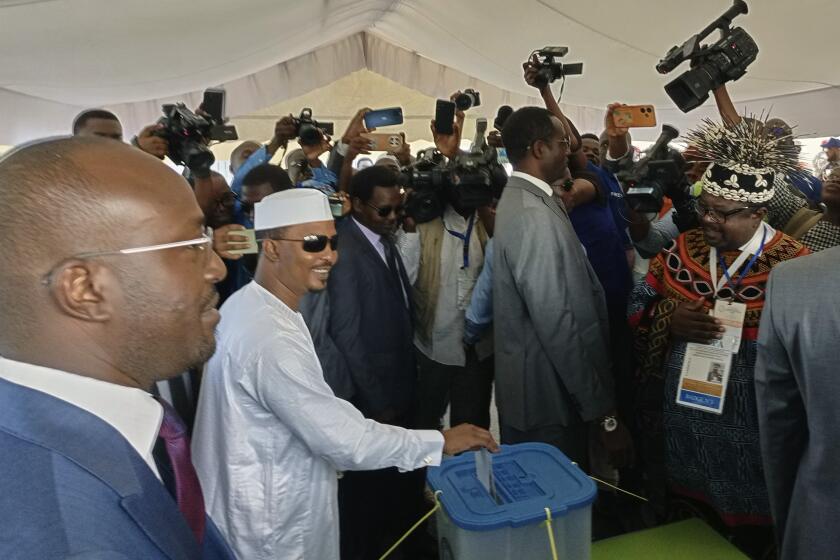Underground Hospital Has Huge Upside
It was 1 a.m., only hours after the start of Israel’s offensive in Lebanon, when hospital deputy director Moshe Daniel received warning of imminent rocket attacks by Hezbollah militants.
Within an hour, 180 patients of the Western Galilee Hospital -- children, the elderly, newborns and expectant mothers -- were moved into the hospital’s labyrinth of underground bomb shelters.
The evacuation in the early hours of July 13 marked the first use of Israel’s only underground medical facility, a warren of concrete tunnels and bunkers with 450 beds that has become the front-line treatment center for wounded soldiers and residents in northern Israel.
“We thought we’d never have to use it,” Daniel said, sitting in his office for an interview that was interrupted by a beeper updating him about new casualties.
The energetic 60-year-old has spent most of the last two weeks at the hospital, returning home only for quick showers and fresh clothes.
“We could go on for months here without any problems,” said Daniel, a decorated veteran of three wars who has treated 60 soldiers under fire.
The hospital has admitted 750 Israelis since the conflict began. In that time, more than 300 rockets have landed in the city, on the Mediterranean coast about five miles from the border with Lebanon.
The underground shelter, which houses about 200 patients, is a maze of about a dozen rooms connected by tunnels wide enough for ambulances to ferry patients from a helicopter landing pad outside.
Previously used for linen deliveries and trash removal, the tunnels are scarred and pitted, the air in them dank and stuffy, the walls stained yellow.
Most of the patients crowd into one large room, the size of an elementary school gymnasium. Curtainless beds provide little privacy, and there is even less tranquillity amid the din of activity.
The wards are marked by printed signs hanging on thin partitions. Relatives hang around where they can, while some patients read newspapers or nap under blue blankets.
Nearby, an intensive-care room holds 20 beds, with barely room to get around them. An adjacent storage closet has been converted into a resuscitation room.
Another room holds infants and children of the hospital staff. The children have been entertained by an Irish folk singer and a clown. Babies in cribs share space with teens, who sit around drawing or singing. Most would have been in summer camps if not for the rocket attacks.
Above the complex, and fortified by 23-inch-thick walls, are bomb-proof operating rooms, protected, like the bunkers, from chemical and biological attacks.
The glass windows at the entrance to the hospital are taped to prevent glass from flying if it is hit in a rocket attack. Dozens of beds are piled near the entrance in preparation for a possible mass casualty event. Several days ago, a number of rockets landed nearby, one at the fence surrounding the hospital.
Daniel came up with the idea of creating an underground facility in 1981, after rockets fired from Lebanon smashed into the hospital and wounded three employees.
He modeled it after an underground hospital in Buffalo, N.Y., his wife’s hometown, which he said was established to house patients during severe snowstorms.
The bunkers appear to reassure the wounded.
“I feel safer in here,” said Boris Naor, 57, who immigrated to Israel from Siberia, Russia, seven years ago. “You can’t hear the noise from the rockets.”
Even among others wounded by the shelling, Naor stood out. His face was dotted with stitches and drying wounds, and his arm and leg were swathed in bandages; he was injured when a rocket slammed through the roof of his house and into his living room. Naor’s wife, Larisa, showed visitors a plastic cup with four bloodstained chips of concrete from the living room wall, which had been taken out of Naor’s arm.
Lives have been saved in the bunkers. This week, a patient was brought in after shrapnel pierced his back, severed a major vein and emerged from his chest. He arrived at the hospital near death, with no pulse and very low blood pressure. After successful surgery, he was brought into the underground recovery room.
Despite the conflict raging outside its walls, the hospital itself is a rare model of coexistence. Built on an old olive grove, the institution has Jewish and Arab patients sharing rooms, both above and below the surface.
Daniel, who says he’s “seen much worse” than the current conflict, acknowledges that he still has to deal with his own fears about the scope of the fighting.
“I’m afraid, always afraid,” he said. “But the problem is knowing how to work under fear. The lives of people are in our hands.”
More to Read
Start your day right
Sign up for Essential California for news, features and recommendations from the L.A. Times and beyond in your inbox six days a week.
You may occasionally receive promotional content from the Los Angeles Times.






